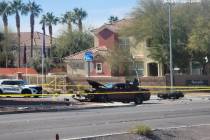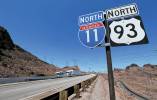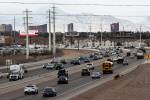Clearing up pesky issue of out-of-state plates
Ouch! The Road Warrior has fallen upon his sword.
In providing an answer last week to a reader who wondered about a neighborhood family who had Hawaii license plates on their four cars for more than six months, the Road Warrior was too simplistic in his response about the state's registration law. Yes, out-of-state plates should be changed to Nevada plates within 30 days, but there are exceptions - as pretty much every member of the U.S. Air Force stationed at Nellis has since pointed out.
Maj. Erin Collins, for one, implored: "Please share this information with your readers and spare our active-duty military members and their families from being unnecessarily put through bureaucratic red tape for no reason."
The Road Warrior snaps to attention. "Sir, yes sir!" Or is that, "Ma'am, yes ma'am!"?
According to the Nevada Department of Motor Vehicles, you are NOT required to register your vehicle here if you are:
■ On active duty in the military service of the United States.
■ An out-of-state student.
■ A student who is registered at a college or university located outside Nevada and who is in the state for a period of not more than six months to participate in a work-study program for which the student earns academic credits.
■ A migrant or seasonal farm worker.
■ A border state employee who commutes into Nevada for employment within 35 miles of the state line.
Looks like the Road Warrior will be pulling KP duty. Now, on to this week's questions.
Peter also has an issue about license plates, and he seeks clarification. He writes that his wife recently was traveling in Northern California when she was ticketed for not having a front license plate on her Cadillac: "She tried to explain to the officer that Nevada does not require a front license plate on an automobile. The officer ... informed her she could request a court date and explain the Nevada law to the judge."
Kevin Malone, spokesman for the Nevada DMV, explains that state law - just like that of California - does require most vehicles to display front and rear license plates at all times, the exceptions being motorcycles and trailers, which require only a rear plate.
"You must display both plates if the vehicle is designed for a front plate or if the manufacturer offers an add-on bracket or frame. Front plates are optional only if 1.) the vehicle was not designed for a front plate and 2.) the manufacturer did not provide an add-on bracket or other means of displaying the front plate."
Fred regularly travels Cheyenne Avenue and is perplexed by the traffic light at Las Vegas Fire Department Station No. 42, near Tenaya Way, which cyclically turns red whether or not there are emergency vehicles entering/exiting. He asks, "Is there a logical explanation for this seemingly unnecessary traffic-congesting activity?"
There definitely is, says Diana Paul of the city of Las Vegas: "The less-than-ideal situation occurs because the emergency signal is located extremely close to the more congested traffic signal at Tenaya. As traffic patterns dictate, the Tenaya signal must serve high volumes of left-turn and cross-street traffic, consequently displaying a red for eastbound and westbound traffic on Cheyenne for significant periods of time.
"When the station signal was installed, it was programmed to stay green for eastbound and westbound traffic on Cheyenne except when a vehicle exited. We observed, however, eastbound traffic stopping for the signal at Tenaya would back up through the station signal. These stopped vehicles interfered with emergency responders attempting to exit.
"In response to this safety concern, the city installed extensive signage and pavement markings in front of the station to provide guidance to the drivers on Cheyenne, directing them to keep the driveways in front of the station clear. Regrettably, the overwhelming majority of motorists failed to comply.
"Therefore, we found it necessary to retime the station signal to operate in conjunction with eastbound and westbound traffic indication at the Tenaya signal. This was implemented by holding the eastbound fire station signal red for a longer period of time than is optimal."
While driving in California, John noticed that electric cars and hybrids were allowed to use the high-occupancy vehicle (HOV) lanes at any time, regardless of the number of occupants. Understandably, he asks, "Are electric cars and hybrids permitted to use HOV lanes at all times in Nevada?"
John is correct that in California, a vehicle that meets specified emissions standards may be issued Clean Air Vehicle decals that allow the vehicle to be operated by a single occupant in the HOV lanes of the state's freeways. But no such decal, no such luck, in Nevada.
Nevada Highway Patrol spokesman Loy Hixson explains: "The Nevada law which regulates the use of the HOV lane states that a vehicle must be a high-occupancy vehicle when using the HOV lane. The meaning of a high-occupancy vehicle is a vehicle that is transporting more than one person; a motorcycle, regardless of the number of passengers; a bus, regardless of the number of passengers; and any other vehicle designated by regulation. The law does not exempt hybrid vehicles."
If you have traffic questions or gripes, email them to roadwarrior@reviewjournal.com. Please be specific, and include your phone number. Not all questions can be answered in print. Follow the Road Warrior on Twitter: @RJroadwarrior.
• Northbound and southbound right lanes and shoulders of U.S. Highway 95 closed, with various onramps and offramps, from Lake Mead Boulevard to Ann Road, from 9:30 a.m. to 3:30 p.m. on staggered days today through Sunday as part of U.S. 95 Northwest Corridor Project.
• Detour of eastbound traffic on Sahara Avenue at Boulder Highway starting today and running through March for storm drain construction project.
• Lane closure on westbound Tropicana Avenue, between Paradise Road and Koval Lane, from 9 p.m. to 5 a.m. daily through Monday for drainage structure repairs.
• Disruptions on Buffalo Drive, between Lake Mead and Charleston boulevards, through late October for road improvements.
• Lane closure on Shadow Lane, between Alta Drive and Charleston Boulevard, through Oct. 31 for utility work.
• Lane closure on Lamb Boulevard, from Oquendo Road to Hacienda Avenue, through Nov. 2 for Water Reclamation District survey.
• Lane closure on Nellis Boulevard, from Hacienda Avenue to Flamingo Road, through Nov. 2 for Water Reclamation District survey.
• Lane closure on Hacienda Avenue, from Lamb Boulevard to Grapevine Springs Park, through Nov. 2 for Water Reclamation District survey.
• Night lane closure on Sunset Road, from Eastern Avenue to McLeod Drive, through Nov. 2 for Water Reclamation District survey.
• Night lane closure on Warm Springs Road, between Tamarus Street and Eastern Avenue, through Nov. 2 for Water Reclamation District survey.
• Night lane closure on Spencer Street, from Warm Springs Road to Eldorado Lane, through Nov. 2 for Water Reclamation District survey.
• Lane restrictions in both directions of Decatur Boulevard, between Lake Mead Boulevard and Rancho Drive, for five weeks for paving and median island improvements.
• Delays on Jones Boulevard from U.S. Highway 95 to Sahara Avenue for widening.
• The intersection of Lake Mead Boulevard and Pecos Road, which has been closed since Sept. 24 to upgrade the Las Vegas Wash main branch box culvert, will reopen at 9 a.m. today, about two weeks ahead of schedule.
GASOLINE PRICES
The average price of gasoline Tuesday in the Las Vegas Valley was $3.81 per gallon; the state average was $3.94; the national average was $3.76.
LAS VEGAS REVIEW-JOURNAL























